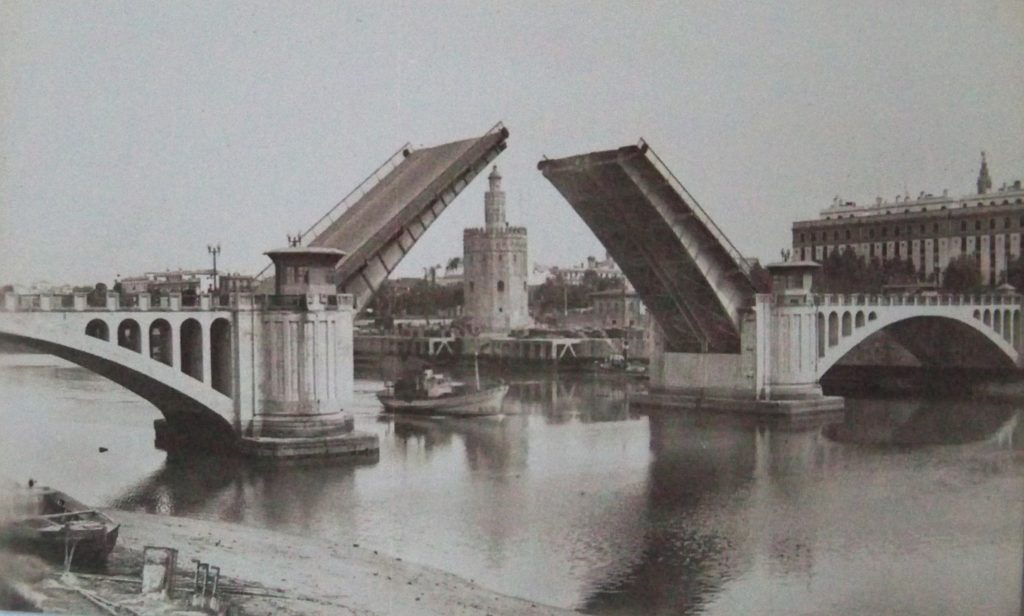
The bridges of Seville have been since ancient times the union between the two banks separated by the Guadalquivir River.
CHRONOLOGY OF THE CITY´S BRIDGES.
We have to go back to the year 1171 to see the first bridge of Seville.
It was the Almohad Caliph Abu Yaqub Yusuf who ordered the construction of the bridge known as “the bridge of boats” ( Ponton bridge ) because its structure was made with boats joined by iron chains. The weight of the boats was extremely heavy to prevent them from sinking.
After 36 days of hard work, the first bridge of Seville was inaugurated on October 9th 1171 and it was in use for almost seven centuries until the middle of the 19th century, when it was decided to build a new one on the same site where the famous bridge of boats was located.
BRIDGE OF ISABEL II. TRIANA BRIDGE.
The second bridge of Seville was built between 1845 and 1852. It was built by the architects Gustavo Steinacher and Ferdinand Bennetot and it was inspired by the Carrousel Bridge in Paris.
During its inauguration there was a military parade and the presence of the seville´s governor. The Archbishop of the city blessed it and gave it the name of Isabel II, ( Queen Isabel II ). It is popularly known as the bridge of Triana since it unites this popular district with the center of the city. It is one of the most emblematic and oldest iron bridges in Spain.
In October 1879 a new bridge was built in Seville. The bridge of Alfonso XII, which was made just for the transportation by train between Seville and Huelva and it was demolished in the year 1959.
A few years later, began the construction of the bridge called “Puente-Pasadera del Agua” in Chapina, a neighborhood near Triana. As a support for the pipes that supplied the water to the city. It was inaugurated in the year 1898.
The first bridge built in the 20th century was the Alfonso XIII Bridge, popularly known as the Iron Bridge. Inaugurated in 1926, it was the emblematic bridge during the Ibero-American Exhibition of 1929.
The next bridge built in Seville was the one that joins the current “Puerta de Jerez” with the “Plaza de Cuba”. The Bridge of San Telmo. Inaugurated in 1931. Originally it was a drawbridge until 1965. Later on it was transformed into a fixed bridge.
Due to the great traffic on the existing bridges, Triana, Alfonso XIII and San Telmo bridges, it was decided to build a new one between the two banks of the river. The Generalissimo Bridge, now the Remedios Bridge.
NEW BRIDGES.
Between 1982 and 1992, 14 new bridges were built in the city of Seville. In the previous eight centuries only eleven were built (1170-1980)
BRIDGES OF THE EXPO.
Due to the Universal Exhibition of 1992, great updates were made to the city and 6 new bridges were built over the Guadalquivir River Basin.
Towards the north we find the bridge of the “Cristo de la Expiración” (Christ of the Expiration) that, among other popular names, is called the “Bridge of the Awnings”, because of the structures that protect the pedestrians from the heat of the city.
Next we have the “Pasarela de la Cartuja”, which due to its dimensions is considered the “slimmest” bridge in the world because of the relationship between its length and width and therefore, it is in the Guinness Book of Records since 2007. It was originally a pedestrian bridge and is now open to road traffic. A little further north we see the “Barqueta Bridge”, so called because it was the name of the city gate that was nearby and from which you could cross the river with a boat. The last bridge on this side of the Town is the famous “Alamillo bridge”, a cable-stayed bridge, built by Calatrava.
To the south stands the Delicias Bridge, built in 1990. It is a double drawbridge that allows the passage of tall boats. Finally, we find the Fifth Centenary Bridge, which owes its name to the fact that it was built for the 1992 Expo in commemoration of the fifth centenary of the Discovery of America. Inaugurated in 1991.
The Sevillians call it “el Paquito” which is the diminutive of “Francisco” because it looks like the “San Francisco bridge”. Thanks to its height any boat can cross it.








No comments yet.